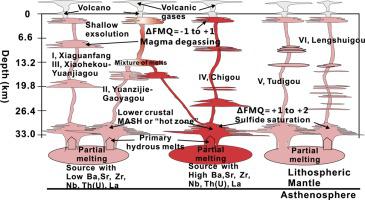当前位置:
X-MOL 学术
›
Earth Planet. Sci. Lett.
›
论文详情
Our official English website, www.x-mol.net, welcomes your feedback! (Note: you will need to create a separate account there.)
The magma plumbing system of Mesozoic Shanyang porphyry groups, South Qinling and implications for porphyry copper mineralization
Earth and Planetary Science Letters ( IF 5.3 ) Pub Date : 2020-08-01 , DOI: 10.1016/j.epsl.2020.116346 Biji Luo , Hongfei Zhang , Liqi Zhang , Chao Zhang , Longmei Shen , Zunqi Xiao , Fabin Pan , He Yang , Zhanke Li , Wangchun Xu , Liang Guo , Lu Tao
Earth and Planetary Science Letters ( IF 5.3 ) Pub Date : 2020-08-01 , DOI: 10.1016/j.epsl.2020.116346 Biji Luo , Hongfei Zhang , Liqi Zhang , Chao Zhang , Longmei Shen , Zunqi Xiao , Fabin Pan , He Yang , Zhanke Li , Wangchun Xu , Liang Guo , Lu Tao

|
Abstract Porphyries, closely associated with the copper deposits worldwide, are usually considered to have high oxygen fugacity and high Sr/Y ratios. However, it is still ambiguous whether the high oxygen fugacity and the enrichment of chalcophile elements are inherited from magma source or obtained by magmatic processes, and the linkage between the high Sr/Y magmas and the formation of porphyry Cu deposits remains unclear. To address these issues, we performed an integrated study of zircon geochronology and oxygen fugacity, petrography, geochemical and Sr-Nd-Hf isotopic compositions for the Shanyang porphyry groups at an intra-continental setting from the South Qinling Orogen, Central China. The Shanyang porphyries can be divided into six groups in terms of their spatial distribution with the crystallization ages ranging from ca. 152 to 140 Ma. They are characterized by high Sr and Ba contents, consistent with the geochemical features of high Ba-Sr granitoids. They show a continuous evolution trend from mafic to felsic samples and mafic samples have high Mg#, Cr, and Ni contents, indicating that they were evolved from mantle-derived basaltic magmas. Most samples display homogeneous ISr (0.704 to 0.706), eNd(t) (−6 to −1.5) and zircon eHf(t) (−4 to +2) values, suggesting that they were derived from an enriched lithospheric mantle with minor crustal contamination. Geochemical results suggest that they were generated by low degree melting of a heterogeneous lithospheric mantle at spinel facies that had been modified by previous slab-derived fluids. These porphyry bodies were derived from multiple magma reservoirs within their distinct plumbing systems and had undergone polybaric differentiation. With magma differentiation, the Shanyang porphyry magmas changed from an oxidized state (ΔFMQ +1 to +2) to a reduced state (ΔFMQ +1 to −0.5). The high (Dy/Yb)N ratios indicate crystallization of garnet had cryptically occurred in the deep crust, which induced sulfide saturation at an earlier stage. This process could result in the deficiency of chalcophile elements and elevate the oxygen fugacity in the residual melts from a relatively reduced parental mafic magma. Degassing in the shallow crust would lead to a decrease in the ƒO2 of the felsic magmas. Thus, some other processes, such as, re-melting of early formed sulfide and gas-brine reactions, are required to concentrate chalcophile elements in the felsic magmas. Our study implies that intra-crustal processes could play a more important role in the enrichment of chalcophile elements and that the oxygen fugacity of the magma system can change during magma evolution. The observations of the Shanyang porphyry groups are very helpful for understanding similar porphyry systems globally. We propose that porphyries worldwide formed in the thickened crust with long-lived magmatic hydrothermal systems in the shallower magma reservoirs are more prone to form porphyry Cu deposits.
更新日期:2020-08-01


























 京公网安备 11010802027423号
京公网安备 11010802027423号